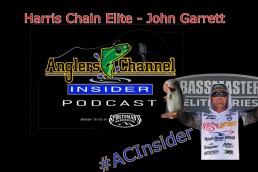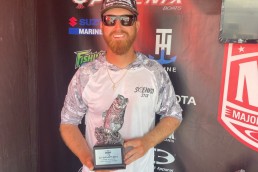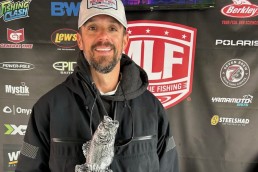CHOKE CANYON SET TO HOST TXTT CHAMPIONSHIP
TXTT Championship Choke Canyon Tournament Details
Friday, October 23:
NO ONSITE REGISTRATION. A check in link will be emailed to all registered teams on Wed, Oct 21. Please text or call Amanda at 210-697-8081 with any questions.
Saturday, October 24 & Sunday, October 25:
Take-off & Weigh-in starts at 3pm on both tournament days.
Calliham Park
700 TX-72
Three Rivers, TX 78071
By David A. Brown
What do you get when the home team isn’t exactly from the home state? Well, in the case of Choke Canyon Reservoir, you get a tremendous fishery that’s ready to offer a bountiful playing field for the Texas Team Trail Championship presented by Bass Pro Shops and Cabela’s, October 24-25.
With the Choke Canyon Dam impounding the Frio River just ahead of its confluence with the Nueces River, this South Texas reservoir has been stocked with Florida-strain largemouth since 1981. Today, local guide and TXTT competitor Mike Bates said the state’s stocking program plus Choke’s remote location have created a giant-factory that offers a tremendous theater for a championship event.
“For pure numbers, it’s better than I’ve ever seen it,” Bates said. “Guide trips have produced 75-100 fish days. And I’m not talking about a bunch of little fish; we’ve had a lot of 4- to 6-pounders. In 30 years of fishing this lake, I’ve never seen the numbers we have now.
“People who’ve never been down here are going to be surprised. Choke Canyon is away from everybody — the nearest metropolitan town is San Antonio, which is about two hours away. She doesn’t get a lot of fishing pressure.”
As of Oct. 13, Choke’s water level stood at 199.42, which is about 21 feet below full pool. As Bates explained, this area of the state doesn’t get the dependable rains of north and east Texas. Nevertheless, a major habitat feature keeps what remains in prime productivity mode.
“Back in 2018 we got a lot of rain in two stages and that got the lake up to 13 feet (below full pool), but now it’s back to 21,” Bates said. “We’re used to fluctuations, but what’s making the lake great is the amount of hydrilla. The lake probably has 13,500 surface acres (currently), but there’s probably 9,000 acres of grass.
“There are plenty of places to fish; there’s hydrilla everywhere. There are still some fish offshore, because we’re still in summer patterns, but there is still plenty of grass for everyone to fish.”
Hot Year Remaining Hot
While the fireworks potential definitely exists, Bates said that given the lingering heat, anglers will definitely have their work cut out for them. Having fished the lake for over 30 years, he’s expecting to find the fish in a transitional phase where they have not yet fully committed to fall patterns.
“Recent daytime temperatures have been as high as 104 and the water temperature is 81-82, so it’s still pretty warm,” Bates said. “We will have had a couple of cold fronts by tournament weekend, so it could easily change into the fall pattern in a week.
“The fish want to go into that fall stuff, but every day has been at least in the mid-90s, so they’re not there yet. If a cold front comes in and pushes that water temperature down, that will help because those Florida bass like water temperatures of 65-75. That’s when they really get going.”
Unless and until that change happens, the Championship anglers will have to reach deep into their wells of knowledge in order to match wits with Choke’s moody bass. Considerably more weather sensitive than their northern strain cousins, “Floridas,” as they’re colloquially known, often display incredible aggression during brief feeding windows, but then slip into lethargy.
“The guys that do really well are going to have to continually adapt,” Bates said. “For me every day is a brand new day.”
Likely Patterns
According to Bates, Championship competitors can expect all of Choke’s waters to be in play. Equally broad is the array of potentially productive baits.
“There hasn’t been a bad spot on the lake that I’ve looked at,” Bates said. “You can catch fish everywhere and there’s not a certain technique. In the springtime, I have about three rods on the deck, but right now, I have 15-20 rods and every one of them’s catching fish.
“There’s not a particular thing that’s going to be better. A guy just needs to cover water, pick something he’s strong in and stick with that. There’s offshore fish, there’s grass fish; there’s fish that will bite moving baits and fish that will bite slow, bottom baits.”
Dialing it it a little, Bates said Championship anglers will throw a lot of Texas-rigged plastics — flipping and punching presentations — swimbaits, spinnerbaits, topwaters and crankbaits. Finesse baits, such a dropshots and Ned rigs will produce, but anglers will have to weed through a bunch of small fish to maybe luck into a big bite.
Bates said the biggest bass one of his clients has caught this year — a 10.60 — was about two pounds off the lake’s largest of 2020. He said he would not be surprised to see the Championship produce a double digit fish.
“Everybody’s going to catch fish, but the guys that do well are going to be the guys that find the bigger fish,” Bates said. “It’s going to take mid- to low-20s both days to win it. If someone finds two giants a day, it might take more. A local tournament in September took 25 to win and Big Bass was 8 pounds.
“The key is getting away from the 2- and 3-pounders. You can get in a little stretch where you catch numbers of those fish. It’s fun fishing, but it won’t be fun for the tournament.”
The good thing about Choke’s double blessing of quality and quantity is that it’s less likely anyone will run away with the event. In fact, Bates said he expects a tight leaderboard with ounces separating those at the top.
“I think this is going to be a nail biter,” he said. “It’s going to be a smorgasbord, but some days they’ll eat a bait and the next day they won’t touch it. You have pure Florida’s in this lake and when there’re eating, it’s great. When they’re not, it’s tough.”























